
Prologue
What we are doing, and why we're doing it!Natural Bridges N.P. - 5/12/05
Petrified Forest N.P. - 4/30/05
Having finished with painting and plumbing, it was time to explore a little bit. We decided to take the ferry to Vancouver Island to visit family and do some more exploring.
Our first major stop on the Island was the second oldest settlement in British Columbia, Victoria. The folks in Victoria take their ties to England and their royal association seriously. The British influence is apparent in their food, architecture, and politics. It is truly a charming city but without being "cutesy."
Being the provincial capital, Victoria is home to the British Columbia Provincial Parliament. They are justifiably proud of the buildings, and light it up to show it off every night. Actually, it was built in the year of Queen Victoria's diamond jubilee. Each light was to represent a symbolic diamond. 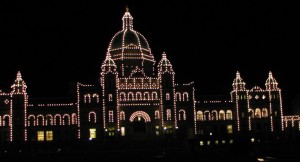 When we were there, Parliament was in session so we stopped in to listen to the proceedings. It was a little dull until one of the ministers launched into a tirade about how far the government-run hydroelectric company was in debt because of the energy crisis in California. Hearing some ministers heckle during the speech and others cheer and pound on their desks wasn't quite what we expected! We did participate in the short tour of the main rotunda and Carissa and Ian were impressed enough that they are looking forward to visiting the national parliament buildings in Ottawa, Ontario and contrasting them with what we'll see in Washington, D.C. Heck, so are we.
When we were there, Parliament was in session so we stopped in to listen to the proceedings. It was a little dull until one of the ministers launched into a tirade about how far the government-run hydroelectric company was in debt because of the energy crisis in California. Hearing some ministers heckle during the speech and others cheer and pound on their desks wasn't quite what we expected! We did participate in the short tour of the main rotunda and Carissa and Ian were impressed enough that they are looking forward to visiting the national parliament buildings in Ottawa, Ontario and contrasting them with what we'll see in Washington, D.C. Heck, so are we.
The historic downtown area of Victoria evolved around the "Inner Harbor." The Parliament Buildings, the wonderful Provincial Museum, and a wonderful old hotel named 'The Empress' (built by the same architect as the Parliament Buildings) dominate the waterfront. 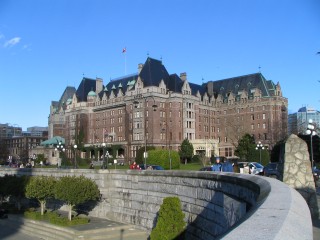 Several blocks of beautifully restored buildings surround them. Most of the old section of Victoria caters to the tourist trade, but it's all done in good taste. The harbor is just big enough for the ubiquitous float-planes, the ferry to Port Angeles Washington, and a few guest docks.
Several blocks of beautifully restored buildings surround them. Most of the old section of Victoria caters to the tourist trade, but it's all done in good taste. The harbor is just big enough for the ubiquitous float-planes, the ferry to Port Angeles Washington, and a few guest docks. 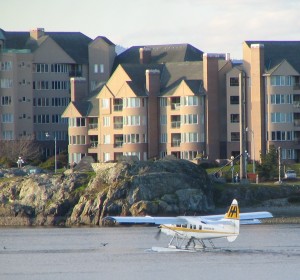
While Victoria is a wonderful city, a couple of days visiting provided plenty of time to see the sights and have time to visit family in this area. We headed north up the main highway (actually the only road) that runs the north/south length of the Island.
A couple of hours leisurely drive brought us to the outskirts of Nanaimo, the largest 'real' city up Island. We camped just south of the city atop the bluffs that overlook Nanaimo Bay. The early morning view across the marshland and the bay was wonderful. While we had been blessed with warm days, the nights were frosty cold. The chill left the marsh with frost so thick that it looked like it had been dusted with snow. Even though it was freezing out, it was still great to go for a hike along the bay. The geese loved it. 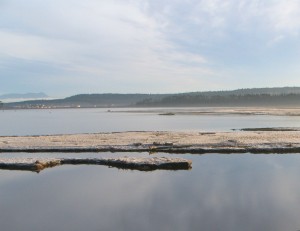
While visiting relatives in Nanaimo, we were introduced to a local craze: deep fried candy bars! A local fish & chips restaurant has a huge selection of candy bars. They'll dip your selection in a cinnamon spiced batter and deep fry it. If they don't have your favorite candy bar, you can bring your own and they'll fry it for a buck. Talk about getting 'sweeted out', but the kids loved it!
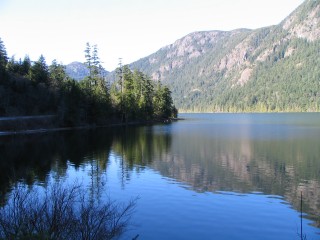 There is only one paved road (Hwy 7) that crosses from the east coast of the Island to the wild and windswept west coast. It leaves the protected waters of the Georgia Straight (between the Island and the mainland) and ends up on the exposed North Pacific coast. The drive to the west coast showcases some of the most spectacular scenery that I've ever seen. It also boasts the steepest grade that we have ever seen on a paved road!
There is only one paved road (Hwy 7) that crosses from the east coast of the Island to the wild and windswept west coast. It leaves the protected waters of the Georgia Straight (between the Island and the mainland) and ends up on the exposed North Pacific coast. The drive to the west coast showcases some of the most spectacular scenery that I've ever seen. It also boasts the steepest grade that we have ever seen on a paved road! 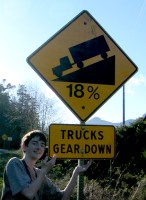 The climb back up had our big American V8 pumping out some serious power. One of our stops included a cascade where the river ran through a narrow point in the canyon. Flood waters had cleared the area of any trace of soil or vegetation, and the river had cut a deep narrow gorge through the rock. The rocky landscape was pockmarked with small ice-capped puddles, and the river itself cascaded into pools too deep to gauge even through crystal clear water. We loved jumping from rock to rock and sometimes in the puddles. Again, the scenery was dramatically beautiful and the weather was gorgeous.
The climb back up had our big American V8 pumping out some serious power. One of our stops included a cascade where the river ran through a narrow point in the canyon. Flood waters had cleared the area of any trace of soil or vegetation, and the river had cut a deep narrow gorge through the rock. The rocky landscape was pockmarked with small ice-capped puddles, and the river itself cascaded into pools too deep to gauge even through crystal clear water. We loved jumping from rock to rock and sometimes in the puddles. Again, the scenery was dramatically beautiful and the weather was gorgeous. 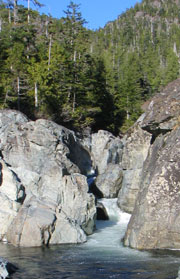
There are only two small towns at the western end of Hwy 7. They were both originally fishing villages that have evolved into tourist havens -- ecotourism and sports fishing. There are still some hardy souls that earn a living from the sea though. When we were at the wharf in Tofino a boat was unloading crates of huge Guiduck clams. 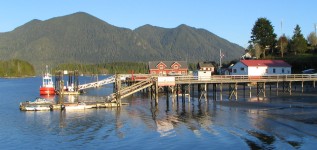 While the boat was being unloaded we noticed another fishing boat wrecked on the shore across the bay. It was a poignant reminder of how hostile the ocean in this area can be. Remember that the ocean waves build as they make their way across the entire Pacific. We've seen fishing net floats from Japanese fishing boats and other refuse from Japan on the beaches. Not a lot, but it is a reminder.
While the boat was being unloaded we noticed another fishing boat wrecked on the shore across the bay. It was a poignant reminder of how hostile the ocean in this area can be. Remember that the ocean waves build as they make their way across the entire Pacific. We've seen fishing net floats from Japanese fishing boats and other refuse from Japan on the beaches. Not a lot, but it is a reminder. 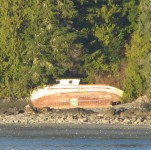
The heavy seas that frequent the coast bring big surf, and where there is surf, there are surfers! We stopped at a beach to make dinner and watched wetsuit clad surfers walking across frosty logs to get back to the parking lot. I'm not sure if I was more impressed at how tough they are or how crazy they are! Even though surfing in stupid cold water wasn't appealing, the sunset was spectacular!
Having returned to the east coast of the Island we continued working our way north. We were, at last, heading into territory that we'd not traveled before. The personality of the area 'up Island' from Nanaimo is distinctly different from the southern part of the island. Mostly small towns where people make their living from their environment. In addition to the ever present logging trucks, we saw numerous wharves & packing plants for fishing and oyster boats. The oyster packing plants were easy to spot as they were invariably surrounded by pure white hills of discarded oyster shells. Thank goodness it was February -- we could only imagine what the scent must be like after things heated up.
Instead of heading all the way up to the northern tip of the island (about 350 miles), we boarded a ferry back to an area on the mainland that is inaccessible by road. The area is called the 'Sunshine Coast', and only boasts one town of any significance: Powell River. The area is known to have the mildest weather anywhere in Canada. It certainly lived up to it's reputation while were there.
The area is called the 'Sunshine Coast', and only boasts one town of any significance: Powell River. The area is known to have the mildest weather anywhere in Canada. It certainly lived up to it's reputation while were there.
While passing through Powell River, we stopped for a delightful visit with a friend. Her house is a 'heritage home'. The house boasts a gorgeous view of sunsets over the Georgia Straight and Vancouver Island through antique windows. The light switches were notable, as some of them were Bakelite, while others were rotary switches housed in ceramic cases. They were mounted on (rather than in) the lath and plaster walls. In this area of Powell River it is said that 90% of the homes were built before the 1940s. This was the heyday of the local pulp mill that is now running at reduced capacity while producing much less pollution.
The trip back to Vancouver was a day-long affair featuring two ferry rides through stunningly beautiful seascapes. We kept a watch for orca, but (according to one of the ferry's deck hands) they don't come close to the coast since the salmon were fished out. 